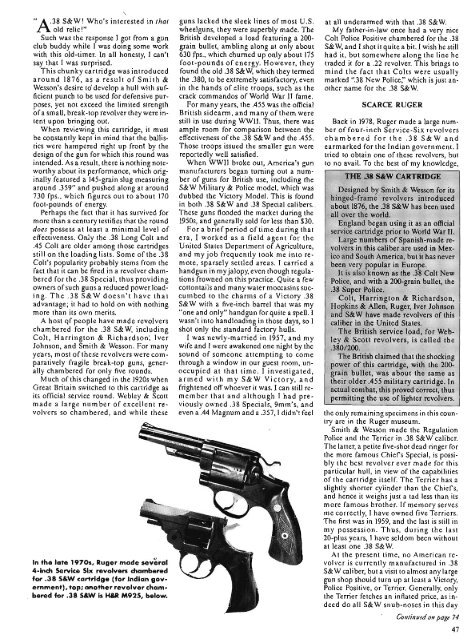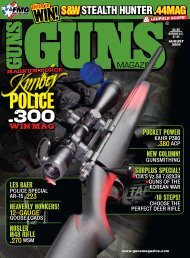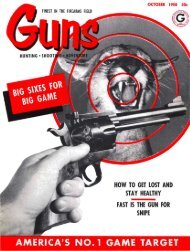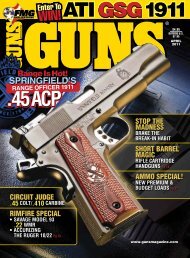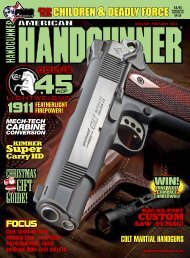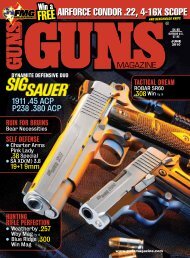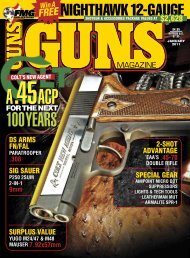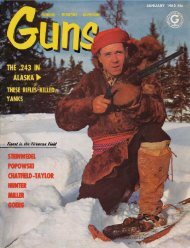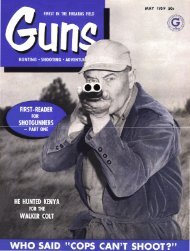NEW! - Jeffersonian
NEW! - Jeffersonian
NEW! - Jeffersonian
Create successful ePaper yourself
Turn your PDF publications into a flip-book with our unique Google optimized e-Paper software.
\<br />
"A38 S& W! Who's interested in that<br />
old relic!"<br />
Such was the response I got from a gun<br />
club buddy while I was doing some work<br />
with this old-timer. In all honesty, I can't<br />
say that I was surprised.<br />
This chunky cartridge was introduced<br />
around 1876, as a result of Smith &<br />
Wesson's desire to' develop a hull with sufficient<br />
punch to be used for defensive purposes,<br />
yet not exceed the limited strength<br />
ofa small, break-top revolver they were intent<br />
upon bringing out.<br />
When reviewing this cartridge, it must<br />
be constantly kept in mind that the ballistics<br />
were hampered right up front by the<br />
design ofthe gun for which this round was<br />
intended. As a result, there is nothing noteworthy<br />
about its performance, which originally<br />
featured a l45-grain slug measuring<br />
around .359" and pushed along at around<br />
730 fps., which figures out to about 170<br />
foot-pounds of energy.<br />
Perhaps the fact that it has survived for<br />
more than a century testifies that the round<br />
does possess at least a minimal level of<br />
effectiveness. Only the .38 Long Colt and<br />
.45 Colt are older among those cartridges<br />
still on the loading lists. Some of the .38<br />
Colt's popularity probably stems from the<br />
fact that it can be fired in a revolver chambered<br />
for the .38 Special, thus providing<br />
owners ofsuch guns a reduced power.1bading.<br />
The .38 S&W doesn't have that<br />
advantage; it had to hold on with nothing<br />
more than its own merits.<br />
A host Qf people have made revolvers<br />
chambered for the .38 S&W, including<br />
Colt, Harrington & Richardson; Iver<br />
Johnson,' and Smith & Wesson. For many<br />
years, most ofthes'e revolvers were companitively<br />
fragile break-top guns, generally<br />
chambered for only five rounds.<br />
Much of this changed in the 1920s when<br />
Great Britain switched to this cartridge as<br />
its official service round. Webley & Scott<br />
made a large number of excellent revolvers<br />
so chambered, and while these<br />
In the late 19705, Ruger made several<br />
4-inch Service Six revolvers chambered<br />
for .38 S&W cartridge (for Indian government),<br />
top; another revolver chambered<br />
for .38 S&W is H&R M925, below.<br />
AMERICAN HANDGUNNER • JANUARYIFEBRUARY 1983<br />
guns lacked the sleek lines of most U.S.<br />
wheelguns, they were superbly made. The<br />
British developed a load featuring a 200<br />
grain bullet, ambling along at only about<br />
630 fps., which churned up only about 115<br />
foot-pounds of energy. However, they<br />
found the old .38 S&W, which they termed<br />
the .380, to be extremely satisfactory, even<br />
in the hands of elite troops, such as the<br />
crack commandos of World War II fame.<br />
For many years, the .455 was the official<br />
British sidearm, and many ofthem were<br />
still in use during WWII. Thus, there was<br />
ample room for comparison between the<br />
effectiveness of the .38 S&W and the .455.<br />
Those troops issued the smaller gun were<br />
reportedly well satisfied.<br />
When WWII broke out, America's gun<br />
manufacturers began turning out a number<br />
of guns for British use, including the<br />
S&W Military & Police model, which was<br />
dubbed the Victory Model. This is found<br />
in both .38 S&W and .38 Special calibers..<br />
These guns flooded the market during the<br />
1950s, and generally sold for less than $30.<br />
For a brief period of time during that<br />
era, I worked as a field agent for the<br />
United States Department of Agriculture,<br />
and my job frequently took me into remote,<br />
sparsely settled areas. I carried a<br />
. handgun in my jalopy, even though regulations<br />
frowned on this practice. Quite a few<br />
cottontails and many water moccasins succumbed<br />
to the charms of a Victory .38<br />
S&W with a five-inch barrel that was my<br />
"one and only" handgun for quite a spell. I<br />
wasn't into handloading in those days, so I<br />
shot only the standard factory hulls.<br />
I was newly-married in 1957, and my<br />
wife and I were awakened one night by the<br />
sound of someone attempting to come<br />
through a window in our guest room, unoccupied<br />
at that time. I investigated,<br />
armed with my S&W Victory, and<br />
frightened off whoever it was. I can still remember<br />
that and although I had previously<br />
owned .38 Specials, 9mm's, and<br />
even a.44 Magnum and a .357, I didn't feel<br />
at all underarmed with that .38 S&W.<br />
My father-in-law once had a very nice<br />
Colt Police Positive chambered for the .38<br />
S&W, and I shot it quite a bit. I wish he still<br />
had it, but somewhere along the line he<br />
traded it for a .22 revolver. This brings to<br />
mind the fact that Colts were usually<br />
marked ".38 New Police:' which is just another<br />
name for the .38 S&W.<br />
SCARCE RUGER<br />
Back in 1978, Ruger made a large number<br />
of four-inch Service-Six revolvers<br />
chambered for the .38 S&W and<br />
earmarked for the Indian government. I<br />
tried to obtain one of these revolvers, but<br />
to no avail. To the best of my knowledge,<br />
THE .38 S&W CARTRIDGE<br />
Designed by Smith & Wesson for its<br />
hinged-frame revolvers introduced<br />
about 1876, the .38 S&W has been used<br />
aU over the world.<br />
England began using it as an official<br />
service cartridge prior to World War II.<br />
Large numbers of Spanish-made revolvers<br />
in this caliber are used in Mexico<br />
and South America, but it has never<br />
been very popular in Europe.<br />
It is also known as the .38 Colt New<br />
Police, and with a 200-grain bullet, the<br />
.38 Super Police.<br />
Colt, Harrington & Richardson,<br />
Hopkins & Allen, Ruger, Iver Johnson<br />
and S&W have made revolvers of this<br />
caliber in the United States.<br />
The British service load, for Webley<br />
& Scott revolvers, is called the<br />
.3801200.<br />
. The Britishclaimed that the shocking<br />
power of this cartridge, with the 200<br />
grain bullet, was about the same as<br />
their older .455 military cartridge. In<br />
actual combat, this proved correct, thus<br />
permuting the use of lighter revolvers.<br />
the only remaining specimens in this country<br />
are in the Ruger museum.<br />
Smith & Wesson made the Regulation<br />
Police and the Terrier in .38 S&W caliber.<br />
The latter, a petite five-shot dead ringer for<br />
the more famous Chiefs Special, is possibly<br />
the best revolver ever made for this<br />
particular hull, in view of the capabilities<br />
of the cartridge itself. The Terrier has a<br />
slightly shorter cylinder than the Chiefs,<br />
and hence it weighs just a tad less than its<br />
more famous brother. Ifmemory serves<br />
me correctly, I have owned five Terriers.<br />
The first was in 1959, and the last is still in<br />
my possession. Thus, during the last<br />
20-plus years, I have seldom been without<br />
at least one .38 S&W.<br />
At the present time, no American revolver<br />
is currently manufactured in .38<br />
S&W caliber, but a visit to almost any large<br />
gun shop should turn up at least a Victory,<br />
Police Positive, or Terrier. Generally, only<br />
the Terrier fetches an inflated price, as indeed<br />
do all S&W snub-noses in this day<br />
Continued on page 74<br />
47


